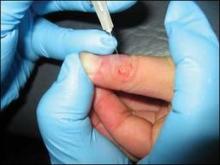SAN FRANCISCO – The current savior of dermatologists who treat pediatric warts is immunotherapy with Candida antigen, according to Dr. Sheila Fallon Friedlander.
"Warts are either the bane of your existence or the bread and butter," she said at the Women’s & Pediatric Dermatology Seminar sponsored by Skin Disease Education Foundation (SDEF). Candida antigen injections are not her first-line treatment choice, and injections aren’t desirable for some warts (such as those on the face), but she said Candida antigen is effective.
"There’s a lot of experience out there now. Candida truly does work, but you’ve got to be aware of side effects," said Dr. Friedlander, professor of clinical pediatrics and medicine at the University of California, San Diego.
Articles in the medical literature suggest injecting up to 0.3 cc of Candida antigen directly into the substance of the largest wart. "Who are they kidding?" she scoffed. The wart would have to be a giant one to hold that much. "Get what you can directly into the wart," she suggested.
There’s controversy about whether it’s most important to get Candida antigen into the wart, the dermis, or both. Dr. Friedlander said she tries to do both. There’s no need to treat all warts; usually injecting one to three will suffice. Repeat the treatment every 3 weeks for a total of three to five treatments, she said.
One study found a relapse rate of 5% after 2 years, compared with relapse rates of 39% with cryotherapy and 10% with laser therapy (Arch. Dermatol. 2001;137:451-5).
Be sure to warn the family that the treatment may cause discomfort, redness, and swelling. Dr. Friedlander said she is cautious about injecting distal fingers because of a report of complications from Candida antigen injections of a patient’s distal left thumb and the distal subungual area of the left index finger. Within 24 hours the patient had a painful purple index finger with tremendous edema requiring incision (Dermatitis 2005;16:38-40).
To choose the best treatment for pediatric warts, consider some key questions, she advised. Are the lesions truly warts or something else (molluscum or Spitz nevi)? Is the patient well or immunocompromised? Are the warts large or small? Do they create a cosmetic problem? Most importantly, does the patient care that the warts are there?
Unlike acne, which raises concerns about scarring, pediatric warts usually disappear over time without leaving a scar. "Remember, you are the patient’s advocate," which sometimes means clashing with parents over whether to treat a wart, she said.
If you pursue treatment, design a plan the family can live with. Some want only gentle, organic products while others want to take a blowtorch to warts.
Her favorite approach is to start with cryotherapy "for the brave," and in between cryotherapy treatments, have the family use "the triple whammy" – topical salicylic acid, Mediplast, and duct tape, she said. If this isn’t working, and the family wants more, she quickly switches to intralesional Candida for multiple warts. For facial warts, however, she said she prefers tretinoin cream, and for periungual warts she prefers cantharidin (blister beetle extract).
Dr. Friedlander recommended a recent review in the May/June 2011 issue of Pediatric Dermatology of these and other treatments for warts that include a complex algorithm for choosing therapies (Ped. Derm. 2011;28:217-29).
A separate prospective randomized trial reported that a triple combination of cantharidin, podophyllotoxin, and salicylic acid worked better than cryotherapy to remove plantar warts (J. Eur. Acad. Dermatol. Venereol. 2011 July 26 [doi:10.1111/j.1468-3083.2011.04186.x]).
Some physicians are using photodynamic therapy to treat warts, but "I think that’s a sledgehammer approach," she said. A Cochrane review of 60 randomized controlled trials reported that topical salicylic acid has the best evidence for treating warts, but that review did not include Candida antigen, she added (Cochrane Database Syst. Rev. 2006 July 19;3:CD001781).
Dr. Friedlander said she has been a speaker, consultant, or researcher for Pierre-Favre, Onset Therapeutics, Ortho/Johnson & Johnson, and Galderma.
SDEF and this news organization are owned by Elsevier.



